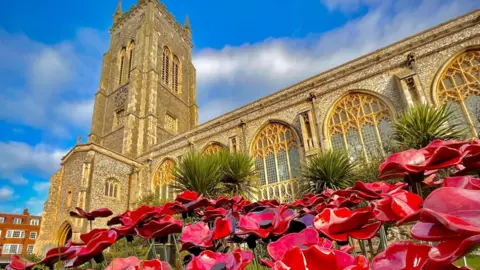Remembrance poppy: Why do we wear poppies and what do they mean

 WalkingTractor/BBC Weather Watchers
WalkingTractor/BBC Weather WatchersAcross the UK, poppies are worn each year to mark Remembrance events and commemorate those who lost their lives in two world wars and other conflicts.
Events and services take place around Armistice Day – 11 November – as well as Remembrance Sunday, and the poppy is a frequent sight throughout.
The Royal British Legion and PoppyScotland run two major campaigns to donate funds from the poppies sold to support current and former members of the armed forces and their families.
The tradition has its origins in World War One but has become a symbol of remembering those who gave their lives in other conflicts.
Here is more on the origin of the poppy, its importance and why they continue to be a symbol of Remembrance in the UK.
Why do we wear poppies, and what do they mean?
In 1915, Canadian doctor Lieutenant Colonel John McCrae wrote his famous war poem, In Flanders Fields, following the devastation he witnessed on battlefields in Ypres, Belgium.
The poem describes the delicate red wildflowers that bloomed where more than a million soldiers died between 1914 and 1918.
Inspired, Anna Guérin, a French teacher turned war effort fundraiser, began selling poppies on designated days from September 1919. She then addressed the American, Canadian and British legions to ask for the poppy to be acknowledged as Remembrance emblem.
In 1921, the Royal British Legion ordered a million poppies from Anna Guérin in France and commissioned a further 8 million to be manufactured in Britain.
They were made from silk, and were sold on 11 November that year in the first ever Poppy Appeal.
The tradition has carried on ever since, though the silk has been consigned to history. In 2023, the legion started making fully recyclable paper poppies.
In 1926 in Scotland, Lady Haig opened Lady Haig’s Poppy Factory, employing former veterans to make the flowers out of tissue. This is the hub that produces the poppies for Poppy Scotland’s poppy appeal.
The Scottish poppy does not feature a green leaf and has four-lobed petals, while England and Wales’s poppy features two.
What do the different coloured poppies mean?
The red poppy commemorates those who sacrificed their lives in World War One and all conflicts that have happened since. It is said to represent remembrance and hope.
A purple poppy is often worn to remember animals that have died in service, particularly horses, a large number of which were killed during World War One.
Donations to the Animal Purple Poppy Fund go to charities including the Household Cavalry Foundation and the World Horse Welfare.
A black poppy commemorates the contributions of black, African and Caribbean communities to the war effort, as servicemen and servicewomen, and as civilians.
The BlackPoppyRose charity was launched in 2010 and aims to end the “ignorance concerning the contribution of Africans and People of African origin to a host of European wars throughout the ages”.
The white poppy represents all victims of war, and are sold by the Peace Pledge Union, which challenges war and seeks nonviolent solutions to war.
How do I wear a poppy?
The Royal British Legion says there is no “correct” way to wear a poppy – just that you must “wear it with pride”. Most people tend to pin one on a coat lapel.
“Wearing a poppy is a personal choice reflecting individual and personal memories,” the legion says.
“It’s a matter of personal choice whether someone chooses to wear a poppy and how they choose to wear it.”
Wreaths, metal pin badges, charms and brooches are also produced every year.
Where else do we see poppies?
The symbol has inspired several large-scale installations in recent years.
A vast display of almost 900,000 ceramic poppies was installed in the Tower of London’s moat 10 years ago.
Each poppy represents the life of a British or colonial soldier who died fighting in World War One.
The poppies were created by artist Paul Cummins, and were sold to the public for £25 each after Remembrance Day in 2014, raising more than £15million for service charities.
In Suffolk, a cascade of thousands of knitted and crocheted poppies has become a village centrepiece, while members of Roses of Ryedale Women’s Institute in North Yorkshire have created a life-size model of a soldier, decorated with knitted poppies, to mark Remembrance Sunday 2024.
In Scotland, landmarks install red lights as part of a nationwide “light up red” campaign.
World News || Latest News || U.S. News
Source link



